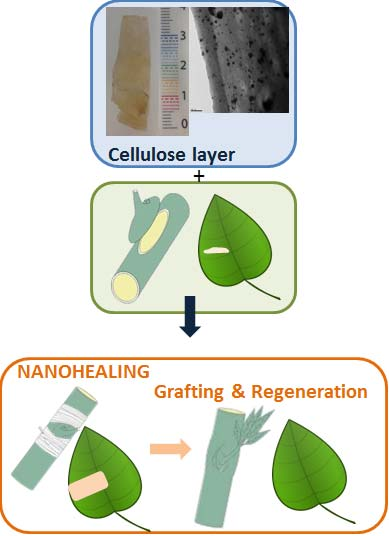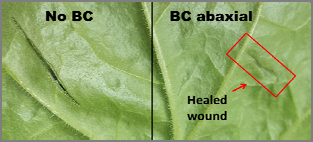CSIC and the Center for Research in Agricultural Genomics have developed an effective method for
plant tissue regeneration that involves the use of a bacterial cellulose-based biopolymer. The
application of this material directly in plant wounds enhances the formation of new cells layers which
boosts the healing processes.
Industrial partners are being sought to exploit the existing know-how through a patent license
agreement.
An offer for Patent Licensing
The regenerative potential of bacterial cellulose
Fig.1 Schematic drawing of treatment Fig. 2 Nicotiana Benthamiana leaf, 48 h post- treatment Plants are constantly exposed to wounding agents such as weather events (hail, wind, freezing), predators (herbivores, insects) or humans (pruning, grafting). Wounds can also occur as a result of normal development during abscission of fruits and leaves or growth cracks. Regardless of their origin, wounds are a breach of the outer protective layers of a plant giving open access to many microbial pathogens that are the causing agents of severe diseases.
Bacterial cellulose (BC) is a very efficient wound healing material currently being used in medicine due to its high biocompatibility. Now, our researchers have observed a regenerating effect in plants according to studies carried out in different species and varied woundings.
The BC material has several advantages of a biopolymer with identical molecular structure as plant cellulose, adding the fact that its chemical purity is higher. BC also has a higher grade of polymerization and crystallinity. Another important aspect of the material is the possibility of combine its structure with anti-pathogenic activity nanoparticles.
The proposed method is an easy-to-use technology applicable to many agricultural practices involving wounding that allows the increase in their efficiency and revenues.
Main innovations and advantages
· Easy-to-use material.
· Short treatment period (wound healing within 48 h) · Combination with one or more antibacterial, antifungal and/or antiviralcomponents for the prevention of infections.
· Material with high porosity, high water absorption capacity andtransparency in the UV-NIR.
· Use and application: Grafting and Agricultural industries









